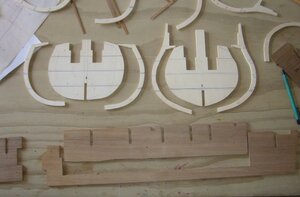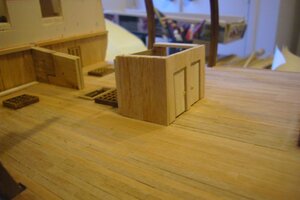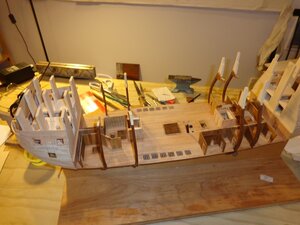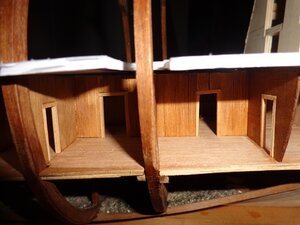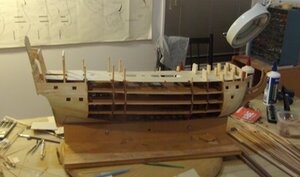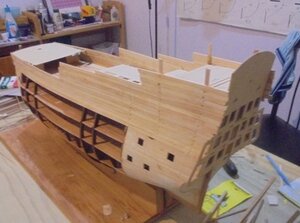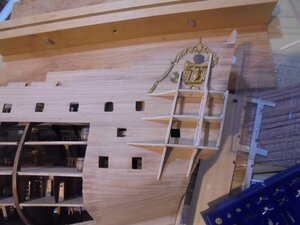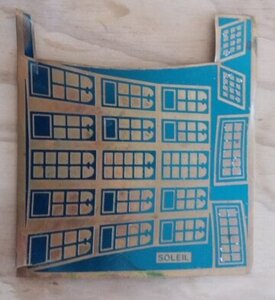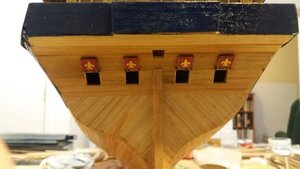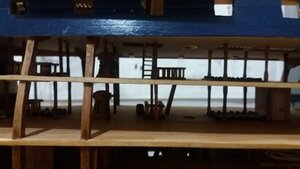The last two ships I did were the Mantua Victory and the Panart San Felipe, and the next one in the pipeline was the Mantua Sergal Soleil Royal.
Although the Soleil Royal would present a challenge in terms of complexity, it wasn’t going to be substantively different than the previous two big ships. I wanted to do something a little different. Of all of the ship models I’ve built, the one that seems to interest most people is the cross section of the USS Constitution.
In a true "it seemed like a good idea at the time" moment, I decided to spice things up by building the Soleil Royal with the sides open and with the inner works displayed. I started the project a while ago and haven't done a build log because I didn't want to start a log I couldn't finish. But the good news is that I finally finished the project and I'd like to share the build experience with you.
The bottom line is that I learned a lot and in retrospect would have done some things differently. But I'm happy with the end result.
In planning the project, I had three big challenges. First, I wanted to use all the metal decorations and as much of the kit as possible, so I was limited as to size and scale. Second, I was concerned about structural support and warping, given that there wouldn't be the normal internal structure of an actual ship or model. Third, and most challenging, I had no real idea how the actual ship looked inside. There was a lot of information on ships of that period and the Wasa and Victory are available for study. I was really lucky and found a book in the Auckland Library by the guy who ran the project to restore the Victory after it was damaged by bombs during WWII.
Accompanying the book is a box containing 17 (huge) sheets of plans. There is one for each deck and it was exactly what I needed. The plans had more than enough detail and with my other research I was now able to create a reasonable (but admittedly not 100% certain) picture of how the Soleil Royal may have looked inside.


My first challenge was to copy the plans which I managed to do by tracing. The Victory plans are about 30% bigger than the model of the Soleil Royal so the next challenge was to draw detailed plans to scale based on the actual dimensions of the model. I needed to keep to the model dimensions because I was going to use the stern and bow decorations provided with the kit and therefore had to use the kit dimensions.
Every time I thought I had solved all my problems, something new and interesting would come up. As I tried to map the dimensions of the Victory deck plans onto the Soleil Royal model plans, things weren’t making sense. I realized that the problem arose because the ship model takes certain liberties with scale in order to make the model look good. These ship models, because of their scale, necessarily have to make tradeoffs between aesthetics and historical accuracy. For one thing, the guns and gun ports are larger than they would have been on a real ship and the rigging is much less complex. Unfortunately, because I was going to use the bow and stern, as well as the quarter deck, forecastle and poop deck as provided in the model, I had to retrofit the revised dimensions to make everything look proportional.
I built up a partial structure using the plywood frames provided in the kit and transferred my deck dimensions to the model:

Once I got the frames and strings aligned properly I marked the deck positions on the frames. I then drew a plan of each deck looking down from the top. I drew a horizontal line depicting the keel in the center of a sheet. I then marked a vertical line at the location of each of the frames. I then laid the marked up frame centered on the horizontal line and marked the outer edge of the deck at each point. This gave me an exact outline of the area of the deck which would be exposed.

I don't want to overwhelm one post with all of the history, so I will add more information in future posts.
Although the Soleil Royal would present a challenge in terms of complexity, it wasn’t going to be substantively different than the previous two big ships. I wanted to do something a little different. Of all of the ship models I’ve built, the one that seems to interest most people is the cross section of the USS Constitution.
In a true "it seemed like a good idea at the time" moment, I decided to spice things up by building the Soleil Royal with the sides open and with the inner works displayed. I started the project a while ago and haven't done a build log because I didn't want to start a log I couldn't finish. But the good news is that I finally finished the project and I'd like to share the build experience with you.
The bottom line is that I learned a lot and in retrospect would have done some things differently. But I'm happy with the end result.
In planning the project, I had three big challenges. First, I wanted to use all the metal decorations and as much of the kit as possible, so I was limited as to size and scale. Second, I was concerned about structural support and warping, given that there wouldn't be the normal internal structure of an actual ship or model. Third, and most challenging, I had no real idea how the actual ship looked inside. There was a lot of information on ships of that period and the Wasa and Victory are available for study. I was really lucky and found a book in the Auckland Library by the guy who ran the project to restore the Victory after it was damaged by bombs during WWII.
Accompanying the book is a box containing 17 (huge) sheets of plans. There is one for each deck and it was exactly what I needed. The plans had more than enough detail and with my other research I was now able to create a reasonable (but admittedly not 100% certain) picture of how the Soleil Royal may have looked inside.


My first challenge was to copy the plans which I managed to do by tracing. The Victory plans are about 30% bigger than the model of the Soleil Royal so the next challenge was to draw detailed plans to scale based on the actual dimensions of the model. I needed to keep to the model dimensions because I was going to use the stern and bow decorations provided with the kit and therefore had to use the kit dimensions.
Every time I thought I had solved all my problems, something new and interesting would come up. As I tried to map the dimensions of the Victory deck plans onto the Soleil Royal model plans, things weren’t making sense. I realized that the problem arose because the ship model takes certain liberties with scale in order to make the model look good. These ship models, because of their scale, necessarily have to make tradeoffs between aesthetics and historical accuracy. For one thing, the guns and gun ports are larger than they would have been on a real ship and the rigging is much less complex. Unfortunately, because I was going to use the bow and stern, as well as the quarter deck, forecastle and poop deck as provided in the model, I had to retrofit the revised dimensions to make everything look proportional.
I built up a partial structure using the plywood frames provided in the kit and transferred my deck dimensions to the model:

Once I got the frames and strings aligned properly I marked the deck positions on the frames. I then drew a plan of each deck looking down from the top. I drew a horizontal line depicting the keel in the center of a sheet. I then marked a vertical line at the location of each of the frames. I then laid the marked up frame centered on the horizontal line and marked the outer edge of the deck at each point. This gave me an exact outline of the area of the deck which would be exposed.

I don't want to overwhelm one post with all of the history, so I will add more information in future posts.






